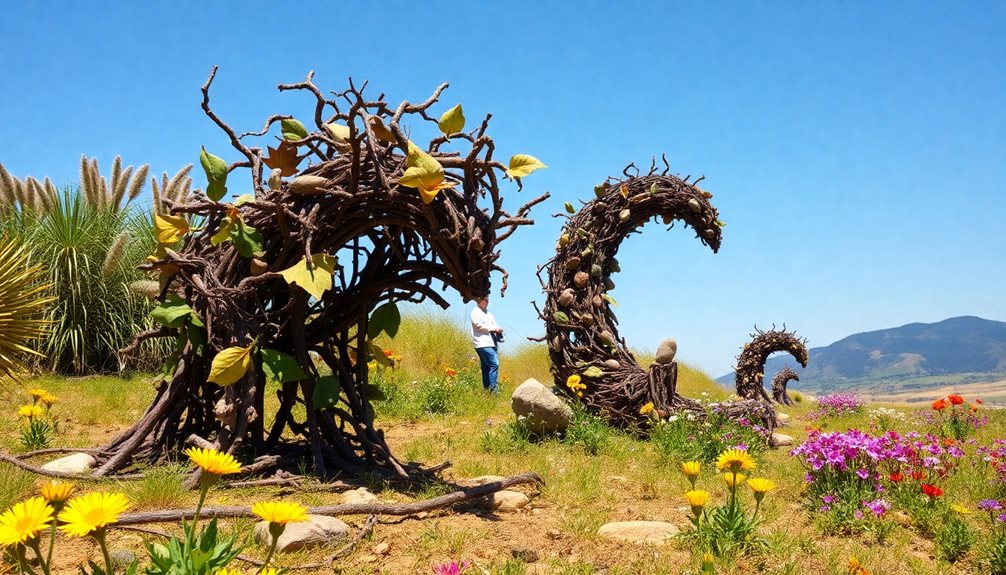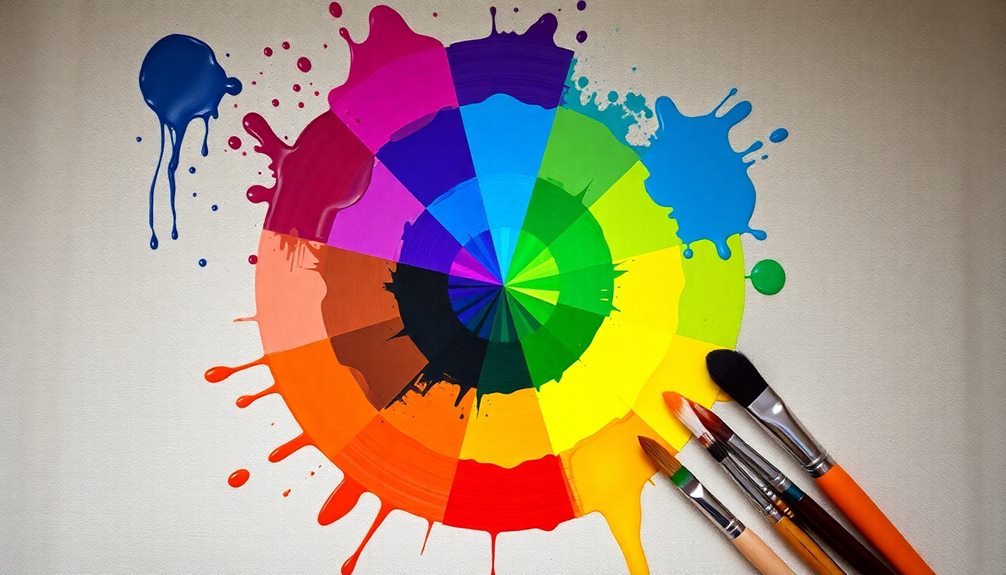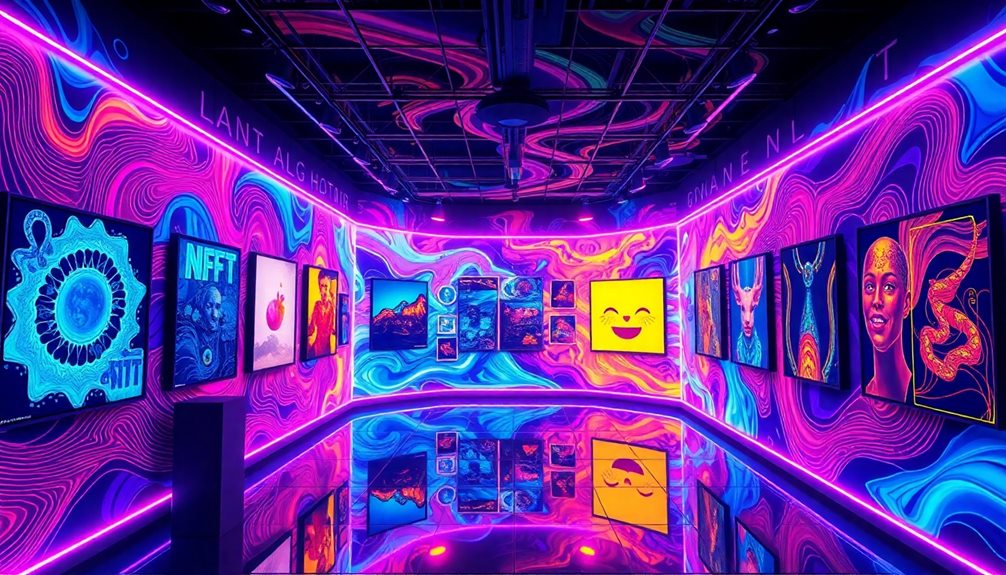Environmental art merges creativity with ecology, challenging you to reflect on your connection to nature. This movement, originating in the 1960s, employs various forms, like land art and installation, to raise awareness about environmental issues. You'll notice artists using natural materials to create site-specific pieces that foster community dialogue. By engaging with these artworks, you're often invited to contemplate climate change and sustainability. Through collaboration with scientists and communities, this art serves not just as expression but also as a catalyst for activism. Stick around to uncover how these elements intertwine and shape the environmental art landscape.
Key Takeaways
- Environmental art combines creativity and ecology, addressing pressing environmental issues through various forms like land art and eco-art.
- Influential artists such as Robert Smithson and Andy Goldsworthy shaped the movement, emphasizing sustainability and ecological consciousness in their works.
- Community involvement is essential, as collaborative projects empower local voices and raise awareness about environmental challenges.
- Both representational and nonrepresentational art effectively communicate environmental messages, engaging audiences through visual appeal and immersive experiences.
- Art serves as a powerful tool for activism, fostering public dialogue and influencing policy changes regarding climate and ecological sustainability.
Definition and Scope

Environmental art represents a dynamic intersection of creativity and ecology, where artists respond to pressing environmental issues through various mediums. This genre combines artistic expression with ecological themes, focusing on cultural responses to issues like climate change.
You'll find that environmental art encompasses a variety of forms, including land art, eco-art, installation, and performance. Artists often use natural materials like soil, leaves, and water, emphasizing their connection to nature.
Moreover, many environmental artworks are site-specific, engaging with particular locations or ecosystems. This approach fosters a dialogue between the artwork, the environment, and the community, making the experience more immersive.
Over the past four decades, the scope of environmental art has broadened, shifting from representational forms to non-representational and performative methods. This evolution encourages you, the viewer, to engage your senses and experiences in new ways.
Ultimately, environmental art doesn't just raise awareness; it promotes sustainability and encourages public involvement in ecological stewardship. By participating in these artistic initiatives, you can actively contribute to the dialogue surrounding environmental issues, making the art a catalyst for change.
Historical Context and Evolution

Environmental art began in the 1960s as a reaction to the growing concerns about environmental degradation and urbanization.
You'll notice how influential artists like Robert Smithson and Andy Goldsworthy shaped this movement, drawing from Land Art and Eco-Art.
This genre not only reflects the changing attitudes towards nature but also engages with community efforts to address ecological issues we face today.
Emergence in the 1960s
In the 1960s, a significant shift in artistic expression emerged as a response to growing concerns about environmental degradation and urbanization. Environmental artists began to prioritize ecological themes, moving away from traditional practices that often ignored the impact of human activity on nature. This change was heavily influenced by movements like Land Art and Eco-Art, which encouraged you to explore the relationship between art and the environment in innovative ways.
Artists utilized natural materials and landscapes, creating works that directly engaged with their surroundings. Key figures like Robert Smithson, with his iconic "Spiral Jetty," and Andy Goldsworthy, known for his site-specific installations, showcased how art could reflect natural processes.
As awareness of climate change grew, these artists incorporated urgent themes into their work, highlighting sustainability and ecological issues. This period not only marked a transformation in artistic practice but also sparked academic interest in the intersection of art and environmental studies.
The cultural implications of environmental art began to be analyzed, reflecting a broader societal shift towards recognizing and addressing our planet's pressing challenges. Through this emergence, environmental art laid the groundwork for future explorations of ecological consciousness in creative expression.
Influential Artists and Movements
As artists responded to the escalating environmental crisis, they forged a distinct movement that evolved from earlier landscape art traditions and the Land Art movement. This evolution began in the 1960s, with key figures like Robert Smithson and Andy Goldsworthy paving the way.
Smithson's "Spiral Jetty" exemplifies how Land Art can transform natural landscapes into powerful statements about environmental degradation. Goldsworthy, on the other hand, utilizes organic materials to create site-specific installations that emphasize nature's beauty and fragility.
The importance of sustainability in contemporary art has been highlighted by advancements in renewable energy technologies, which artists often incorporate into their works to raise awareness about ecological issues.
The movement gained even more momentum in the 1990s, as artists began to view their surroundings as interconnected systems. They tackled ecological issues directly, allowing the Environmental Arts impact to resonate in contemporary discourse.
Influential exhibitions and festivals showcased the synergy between art and nature, raising awareness about climate change and sustainability.
Works like "Land and Environmental Art" by Jeffrey Kastnor and "Art in the Anthropocene" by Heather Davis and Etienne Turpin have deepened academic discussions, framing the historical context and evolution of environmental art.
Representational vs. Nonrepresentational Art

Many artists explore the distinction between representational and nonrepresentational art, especially in environmental contexts. Representational art directly depicts natural landscapes and phenomena, showcasing their aesthetic qualities to raise awareness about environmental issues. Think of artists like Monet and Constable, who use traditional techniques to create recognizable images that draw you into the beauty of nature.
On the other hand, nonrepresentational art shifts the focus from the final product to the audience's experience. This form often employs abstract elements or performative aspects, inviting you to engage with the work in a more interactive way. Notable examples include Turrell's Skyspaces and Richard Long's installations, where the process of creation and your participation become central to the experience.
Both representational and nonrepresentational art serve essential roles in communicating environmental messages. Representational art often captivates you with visual beauty, while nonrepresentational art fosters deeper emotional and intellectual engagement with ecological themes.
This shift reflects a broader trend in art, challenging traditional definitions and encouraging you to reflect on your connection to the environment. Recognizing these differences can deepen your appreciation for how art influences our understanding of ecological issues.
Climate Change Engagement

When you engage with environmental art, you tap into a powerful emotional connection to nature that can inspire activism.
Artists often express urgent climate issues in ways that resonate deeply, prompting you to think critically about your role in the ecosystem.
Through community involvement, these artistic expressions not only raise awareness but also foster a collective commitment to action against climate change.
Emotional Connection to Nature
Environmental art captivates audiences by forging a profound emotional connection to nature, especially in the context of climate change. This art form serves as a powerful medium for communicating climate issues, engaging you on a personal level and fostering a deeper understanding of ecological concerns.
Artists create immersive experiences that invite you to reflect on your relationship with the environment, often through site-specific installations that heighten emotional impact. By emphasizing the fragility of ecosystems and the urgency of environmental crises, environmental art encourages you to contemplate your role in climate change and the importance of stewardship.
The use of natural materials and ephemeral art forms highlights the transient nature of life, reinforcing the pressing reality of climate change. Collaborative projects between artists and scientists further enhance this emotional connection, educating the public on climate issues while inspiring action.
When you engage with these artistic expressions, you not only gain insight into the impact on the environment but also feel a compelling urge to participate in sustainability efforts. Through this emotional lens, art transforms awareness into a call to action, urging you to nurture your bond with nature and advocate for its preservation.
Activism Through Artistic Expression
Art has become an essential tool for activism, effectively rallying people around the urgent issue of climate change. Through environmental art, artists raise awareness and engage the public in discussions about ecological issues. Interactive installations and site-specific works invite you to experience these pressing matters firsthand.
For instance, artists like Olafur Eliasson and Agnes Denes blend artistic expression with advocacy, spotlighting critical topics such as climate change and food sustainability.
Collaborations between artists and environmental organizations amplify the impact of these initiatives. By incorporating scientific knowledge, they address ecological crises more effectively. When you encounter environmental art in public spaces, it not only enhances your surroundings but also promotes community involvement and stewardship.
These installations encourage you to connect with nature and your local environment on a deeper level.
Moreover, environmental art has the power to influence policy changes. Impactful exhibitions and projects can galvanize public support for essential environmental regulations and conservation efforts.
Community Involvement and Awareness
Community involvement plays an essential role in combating climate change, and art serves as a powerful catalyst for engagement. Environmental art fosters collaboration among local populations, encouraging them to take a more active role in addressing the climate crisis.
Through workshops and public installations, these art initiatives promote ecological awareness and facilitate important discussions about climate change and its impacts on your community. Additionally, personalized learning pathways can enhance community education efforts, tailoring engagement strategies to diverse audience needs.
By participating in collaborative projects, you not only enhance your connection to your surroundings but also gain a platform to voice local environmental issues. Case studies show that artistic expression can mobilize community voices, leading to tangible policy changes that reflect the concerns of local residents.
Moreover, when artists partner with scientists and community organizations, the effectiveness of these projects amplifies. Integrating scientific data with artistic narratives creates emotionally resonant experiences that inspire proactive engagement in climate change mitigation efforts.
The Role of Science

Science plays an essential role in shaping the narratives of environmental art, bridging the gap between creative expression and ecological understanding. You'll find that many artists collaborate with scientists to accurately depict pressing environmental issues, ensuring their work communicates the urgency of climate change and ecological degradation.
Incorporating scientific principles, artists often select sustainable and biodegradable materials for their creations, reducing their environmental impact. This thoughtful approach not only enhances their art but also promotes environmental policy awareness. By integrating scientific data, like climate statistics, into installations, artists foster critical dialogue about ecological responsibility.
Here's a visual representation of how science interconnects with environmental art:
| Aspect | Description |
|---|---|
| Collaboration | Artists work with scientists for accuracy. |
| Material Selection | Use of sustainable, biodegradable materials. |
| Data Integration | Incorporating climate stats fosters dialogue. |
Through these practices, artists capture dynamic weather patterns and seasonal changes, reflecting the fragility of nature. By engaging with science, you'll see how environmental art serves as a powerful tool for awareness and change.
Site-Specific Practices

Site-specific practices in environmental art create a direct dialogue between the artwork and its geographical and cultural context.
These practices emphasize the relationship between the artwork and its location, engaging the audience in a unique way. When artists like Robert Smithson and Nancy Holt utilize natural landscapes, they turn the environment into a canvas, as seen in works like Smithson's Spiral Jetty and Holt's Sun Tunnels.
Successful site-specific projects often involve thorough site analysis, considering various dynamics.
Here are key aspects to remember:
- Geographical Context: The artwork reflects the unique characteristics of its location.
- Cultural Relevance: Art often engages with local histories and traditions.
- Community Engagement: Projects encourage interaction and awareness among local communities.
- Natural Materials: Artists commonly use materials sourced from the site, reinforcing ecological connections.
- Ecological Relationships: The exploration of site-specificity enhances understanding of nature in art.
Natural Materials and Sustainability

In the domain of environmental art, using natural materials is crucial for promoting sustainability and ecological awareness. When you choose to work with elements like soil, water, and plant life, you're not only minimizing your environmental impact but also highlighting the profound connection between art and nature. This practice encourages a deeper appreciation for the ecosystems around you.
Sustainable practices in your art-making process can include using biodegradable and non-toxic substances while responsibly sourcing materials. By reducing waste and selecting local resources, you're actively supporting local economies and cutting down on transportation emissions, greatly lowering your carbon footprint.
Furthermore, incorporating natural materials emphasizes the ephemeral nature of your artwork. Many pieces are designed to change or decompose over time, serving as reminders of nature's cycles.
The ethical considerations surrounding your material choices underscore the responsibility artists have in promoting sustainability. By making conscious decisions, you can contribute to environmental stewardship and inspire others to reflect on the impact of their artistic practices.
Embracing natural materials not only enriches your artistic journey but also reinforces the crucial message of sustainability in the world of environmental art.
Art as Activism

Art serves as a powerful catalyst for activism, harnessing creativity to tackle pressing ecological issues. Through innovative visual and experiential narratives, artists raise awareness of climate change and environmental degradation. This approach not only informs but also inspires action, demonstrating the profound impact of art as activism.
Consider these key aspects of environmental art activism:
- Awareness: Artists shine a light on critical environmental issues, prompting public discourse.
- Collaboration: Many artists partner with scientists and organizations to amplify their initiatives.
- Engagement: Art invites community participation, fostering dialogue on local and global environmental concerns.
- Case Studies: Works like Agnes Denes' *Wheatfield, a Confrontation* provoke essential conversations about land use and food production.
- Influence: Successful environmental art can shift public perception and inspire policy changes regarding sustainability.
Community and Collaboration

Environmental art thrives on community and collaboration, amplifying the voices of those directly affected by ecological issues. It often involves community engagement through collaborative projects that unite artists, local residents, and environmental organizations. These partnerships tackle specific ecological challenges and raise public awareness.
Successful case studies, like community-driven installations and eco-art festivals, show how these collaborative efforts cultivate a sense of stewardship and empower local voices in environmental discussions. You'll find that when artists partner with scientists, they combine creativity and scientific knowledge, enhancing the impact of their initiatives. This teamwork not only addresses pressing ecological challenges but also resonates deeply with the community.
Moreover, community organizations play a crucial role in supporting and funding these environmental art projects. Their involvement guarantees that the artworks reflect local contexts and concerns. Engaging in environmental art can lead to tangible changes, such as policy shifts and increased public participation in conservation efforts.
This illustrates the potential of art to catalyze community action and foster a collective sense of responsibility toward the environment. By participating in these projects, you contribute to a powerful movement that champions ecological awareness and action.
Frequently Asked Questions
What Are 4 Main Concerns That Environmental Art Addresses?
When considering environmental art, you'll notice it addresses climate change awareness, sustainability practices, ecological restoration, and the interconnectedness of life. Each concern fosters understanding and inspires action towards a healthier planet.
What Are the Key Features of Environmental Art?
Did you know that 80% of the world's biodiversity is found in forests? Environmental art's key features include site-specific installations, natural materials, sustainability focus, and community engagement, all aiming to connect people with their environment.
What Are the 4 Four Steps of an Art Analysis?
To analyze art, you start by describing its visual elements, then examine the techniques used. Next, interpret the meaning behind it, and finally, assess its effectiveness in conveying messages and engaging the audience.
What Are the 3 Main Parts of an Art Analysis?
You might think art analysis is just about personal opinions, but it's structured. You'll explore description, interpretation, and evaluation to truly grasp the artwork's depth, meaning, and impact, enhancing your appreciation and understanding.
Conclusion
In exploring environmental art, you'll discover how creativity intersects with nature and activism. Just like finding a beautiful leaf on your morning walk, these artworks remind us of our connection to the earth. Whether it's a vibrant mural or a serene installation, each piece tells a story about our planet's fragility. As you engage with this art, you can't help but feel inspired to protect and cherish the environment, making every encounter a chance for positive change.









